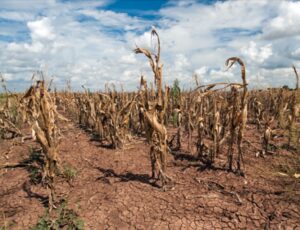There isn’t a shortage of water so much as a longage of people
Paraphrasing Garrett Hardin

This morning I cut down a little piñon tree. It had died during the winter, and was unsightly this spring with dead needles clinging to its branches. It had looked stressed last summer so I had watered it 2 or 3 times, as in previous summers. I guess it was given too little water, too late. This little tree was victim of our megadrought.
There was media coverage when a scientific paper on North American drought was published. Regrettably, the media lost interest in the subject which will affect so many lives. The paper’s title wasn’t prepossessing: “Large contribution from anthropogenic warming to an emerging North American megadrought”. Its two main points were correct, unfortunately. The North American megadrought has emerged. A megadrought is defined by its duration—it must last 20 years or longer. When the paper was written, the drought wasn’t quite that old. An update was published two years later, confirming the concerns of the original paper.
The megadrought started at the turn of millennium, and is still with us as of June, 2024. All of La Plata County, Colorado, is experiencing moderate drought.
The second key point of the paper is that “anthropogenic warming” is a major cause of our drought. Yes, we humans are responsible for almost half of the dryness. These two papers calculate that more than 40% of our megadrought is human caused, due to global heating.
Both articles used tree-ring data to estimate prehistoric rainfall. Since trees grow faster when there is adequate precipitation, this is a valid method to use before records were kept. There are tree-ring data for SW North America that go back 1200 years. The second paper states that the current megadrought is the worst in that whole 1200-year stretch!
Drought isn’t confined to the USA. Mexican farmers faced crop failures caused by a heat dome affecting most of the country. Canada is also suffering. There are areas of extreme drought in the Canadian west where terrible wildfires are burning.
The drought can cause a positive feedback loop with harmful results. Drying of bodies of water, such as the Great Salt Lake, exposes dry earth. Spring winds blow the dark dust onto white snow, causing it to melt sooner. This can cause deluges of early snowmelt and produce flooding—too much water at the wrong time—that doesn’t contribute to groundwater.
How serious is this megadrought? We will see more communities like Rio Verde Foothills, Arizona, where residents have practically no water source. In 2022 Severance, Colorado, realized that its water was already serving the maximum number of people and had to stop issuing building permits. Using foresight, last year Arizona stopped issuing building permits in some areas around Phoenix due to lack of water.
What can we do about the megadrought? Of course, most important is being careful with the water we have. In addition, we need to limit our carbon emissions, because our use of fossil fuels is what is causing the increase in drought. To quote the first megadrought paper: “The magnitude of future droughts in North America and elsewhere will depend greatly on future rates of anthropogenic greenhouse gas emissions globally.”
One of the goals of the local organization, 4CORE (Four Corners Office for Resource Efficiency), is to reduce local carbon emissions. Their programs include making homes more energy efficient, encouraging use of rain barrels to harvest precipitation, and electrification of homes and transportation. Most of all, we must recognize that arid land cannot support many people.
©Richard Grossman MD, 2024